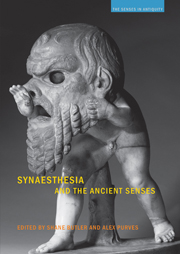Book contents
- Frontmatter
- Contents
- Contributors
- Introduction: synaesthesia and the ancient senses
- 1 Why are there nine Muses?
- 2 Haptic Herodotus
- 3 The understanding ear: synaesthesia, paraesthesia and talking animals
- 4 Aristophanes, Cratinus and the smell of comedy
- 5 “Looking mustard”: Greek popular epistemology and the meaning of δριμύς
- 6 Plato, beauty and “philosophical synaesthesia”
- 7 Manilius' cosmos of the senses
- 8 Reading death and the senses in Lucan and Lucretius
- 9 Colour as synaesthetic experience in antiquity
- 10 Blinded by th light: oratorical clarity and poetic obscurity in Quintilian
- 11 The sense of a poem: Ovids Banquet of Sence (1595)
- 12 Saussure's anaphonie: sounds asunder
- 13 Beyond Narcissus
- Bibliography
- Index
9 - Colour as synaesthetic experience in antiquity
- Frontmatter
- Contents
- Contributors
- Introduction: synaesthesia and the ancient senses
- 1 Why are there nine Muses?
- 2 Haptic Herodotus
- 3 The understanding ear: synaesthesia, paraesthesia and talking animals
- 4 Aristophanes, Cratinus and the smell of comedy
- 5 “Looking mustard”: Greek popular epistemology and the meaning of δριμύς
- 6 Plato, beauty and “philosophical synaesthesia”
- 7 Manilius' cosmos of the senses
- 8 Reading death and the senses in Lucan and Lucretius
- 9 Colour as synaesthetic experience in antiquity
- 10 Blinded by th light: oratorical clarity and poetic obscurity in Quintilian
- 11 The sense of a poem: Ovids Banquet of Sence (1595)
- 12 Saussure's anaphonie: sounds asunder
- 13 Beyond Narcissus
- Bibliography
- Index
Summary
INTRODUCTION
In 1858, William Gladstone, British Prime Minister-to-be and a proficient Homeric scholar, famously argued that Homer's colour system was founded exclusively upon light and darkness, and that the organ of vision “was but partially developed among Greeks”. He was not the first to make such a claim about defective Greek colour vision: a generation before, the German polymath Goethe had made similar claims about ancient art, and others had drawn attention to the material poverty of colour in the ancient Mediterranean environment – the scarcity of dyes, paints and flower varieties, as well as the relative uniformity of ancient body colours. In the nineteenth century, these ideas chimed well with some of Darwin's theories about human evolution and the development of civilization, and some even invoked the newly-discovered phenomenon of colour-blindness to explain ancient insensitivities to colours. The question about the poverty and imprecision of ancient colour vocabulary has been hotly debated by philologists and anthropologists ever since, and studies of ancient colour vision across the last hundred years have been dominated by efforts to demonstrate that the ancients in fact employed a highly sophisticated colour system. This system operated, the argument goes, along somewhat different parameters from our own: rather than hue, the ancients were sensitive primarily to such things as luminosity, saturation and texture, or even less obvious variables such as smell, agitation and liquidity.
- Type
- Chapter
- Information
- Synaesthesia and the Ancient Senses , pp. 127 - 140Publisher: Acumen PublishingPrint publication year: 2013



